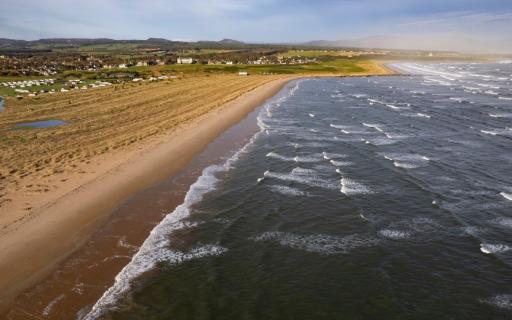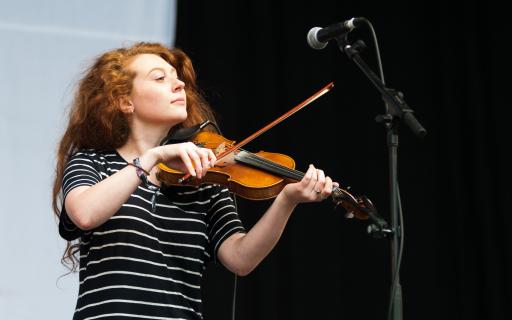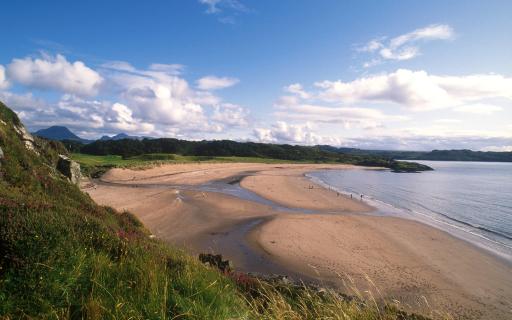
Mousa
The Hjaltland Hentilaags came together from across Shetland to stitch stories of the fascinating natural and cultural heritage of the Shetland Isles and an incredible feat of prehistoric engineering at Mousa.
This is their story.
Towering over the western shores of Mousa (Old Norse - 'the mossy island') is a prehistoric building of national importance.
Brochs, as they are known, were often built from about 100BC to 100AD and are entirely unique to Scotland. Built on spectacular sites, promontories, little hills, these structures would have been prominent features on the landscape.
These double-walled, drystone structures had only one low entrance, intra-mural passages and a winding stone staircase leading to a parapet around the top. The term for them derives from ‘brough’, a Lowland Scots word meaning a fort. The purpose of these structures is still debated with theories ranging from homesteads to fortifications.
The journey stones which surround the Broch of Mousa on the panel are an artistic homage to the incredible natural and cultural heritage of the Shetland Isles. With masterful representations of the internationally renowned Fair Isle knitwear, the fiery Up Helly Aa festival, local flora and wildlife, a peat-cutting tushkar, a fiddle and famous vessels the stones here are a beautiful representation of the things that make the Shetland Isles so special.
 The Broch of Mousa panel
The Broch of Mousa panelImage provided by Kirstie Campbell
A TITAN OF PREHISTORIC ENGINEERING
Thought to have been built around 300BC the Broch of Mousa in the Shetland Isles is the best preserved broch in Scotland, the tallest surviving Iron Age structure in Britain and one of the best preserved prehistoric buildings in Europe. Standing tall at an incredible 13.3m high its dramatic profile, stitched expertly by the Hjaltland Hentilaags, commands the skyline. Inside, a central hearth and floor tank given us small insights into the people who once frequented these walls. Its excellent survival is likely due to its more remote location - only accessible by boat from Sandwick. The Broch of Mousa is one of 120 brochs found in the Shetland Isles and, in fact, stands directly opposite the Burraland Broch, separated only by a narrow stretch of water.
Often cited as an 'archetype' of brochs its iconic image is at the forefront of Scottish prehistory and together with Old Scatness and Jarlshof forms a part of the 'Zenith of Iron Age Shetland' which is a combination of extraordinary archaeological sites currently on the UNESCO programme's Tentative List. Like the other sites in this series human activity at the Broch of Mousa extends past the Iron Age. Featuring as a location in two Norse sagas, the tales shed light into the broch's longer history and the stories that continued to play out within its walls. Today the broch and the wider island of Mousa is an important nesting site for European storm petrels who often seek shelter within the broch itself, just as its Iron Age inhabitants did over 2,000 years ago.
WITH THANKS TO THE HJALTLAND HENTILAAGS STITCHERS
This panel was stitched by Joan, Eleanor, Angharad, Anne, Carol, Janette, Mairi and Mhairi G who gave their time, skill and energy to completing a fantastic artwork for their area.
If you would like to see the panel up close and admire the detail of their work, you can currently view the panel in the Inverness Castle Experience.
EXPLORE MORE STITCHERS STORIES BELOW
Swipe left for more







